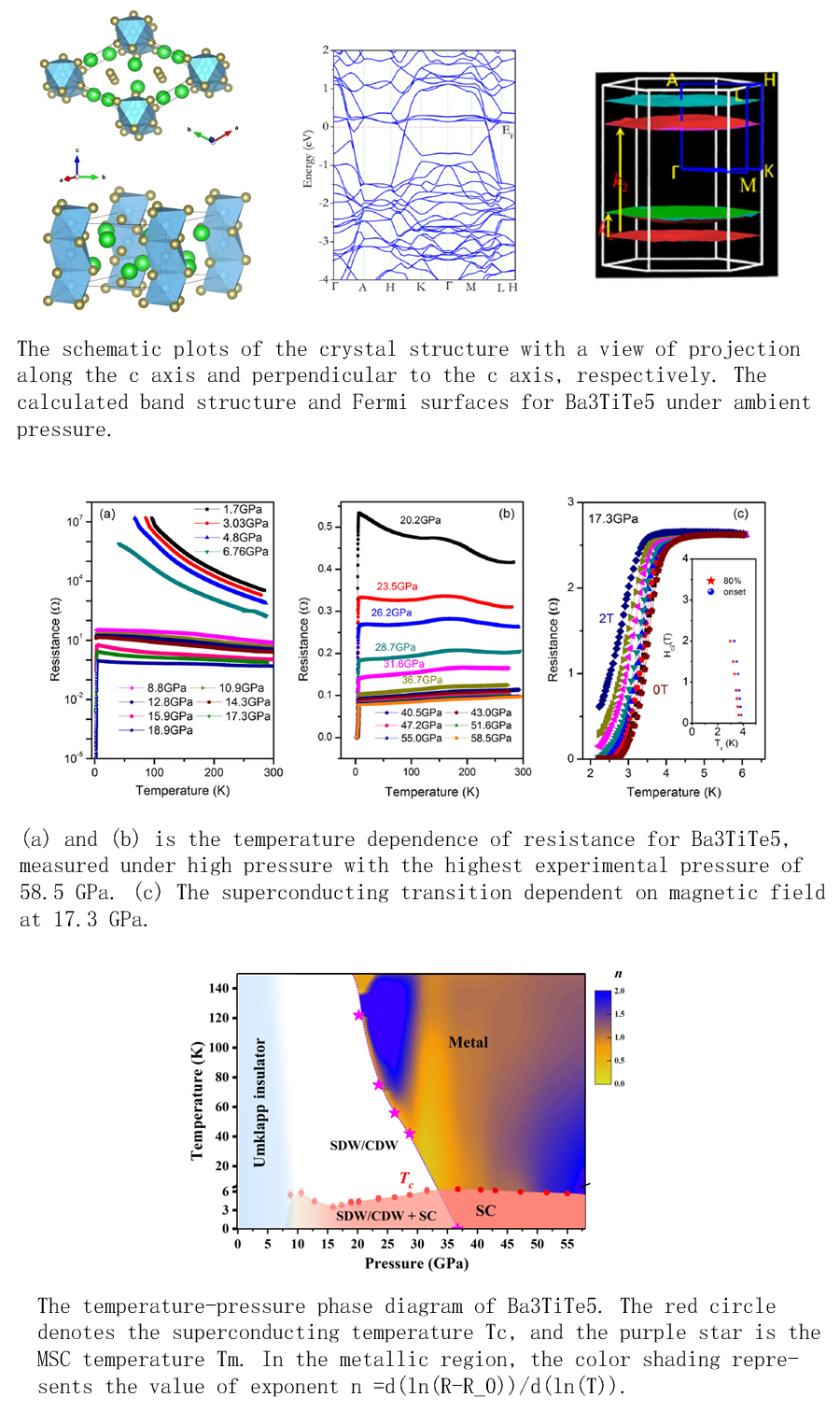高压合成发现新型准1维材料及维度调控的金属化和超导
(A New Quasi One-Dimensional Compound Ba3TiTe5 and Superconductivity Induced by Pressure )
J. Zhang, Y. T. Jia, X. C. Wang, Z. Li, L. Duan, W. M. Li, J. Zhao, L. P. Cao, G. Y. Dai, Z. Deng, S. J. Zhang, S. M. Feng, R. Z. Yu, Q. Q. Liu, J. P. Hu, J. L. Zhu, C. Q. Jin
NPG Asia Materials 11, 60 (2019) Highlights: 中科院(CAS), 中科院之声, 中科院物理所(IOP) and 材料科学与工程
对于一维导电体系来说,其电子的运动受维度限制只能沿前后两个方向运动,因此一维体系的所有电子相互关联,表现为集体运动的形式,不再有由费米液体理论所描述的准粒子存在,只能由Luttinger液体理论来描述。正是由于一维体系电子的集体运动, Umklapp倒散射效应在一维导电体系中的电学行为中具有非常重要的影响,引发金属-绝缘体相变。导电链之间的电子跃迁将抑制Umklapp倒散射引起的金属-绝缘体相变,随着一维导电体系逐渐向三维金属过渡,在维度演化过程中将产生超导等丰富的物理现象。目前的研究主要集中在(TMTTF)2X和(TMTSF)2X(X=TaF6,AsF6,PF6,ClO4,ReO4等有机材料,),这些有机一维导电材料结构复杂,缺乏对一维导电链向三维金属过渡的系列物理现象的深入研究。
我们利用高压高温条件制备发现新的准一维无机导体材料Ba3TiTe5,并详细研究了该一维导体在压力调控下向三维金属演化过程中出现的系列有趣物理现象。研究结果表明:(1)Ba3TiTe5是理想的准一维导体,其电子能带结构具有典型的一维导电特征;常压没有磁性,由于Umklapp倒散射效应发生了金属-绝缘体相变,呈现为半导体行为。(2)当施加压力增大导电链之间电子跃迁几率,Umklapp倒散射导致的金属-绝缘体相变被完全抑制时,体系将从Luttinger液体向三维金属过渡,同时实验发现了超导;当远离Luttinger液体区域,超导转变温度Tc开始下降,表明该超导现象与Luttinger液体失稳相关。(3)进一步增大压力,Ba3TiTe5材料体系进入到三维金属区域。由于其费米面仍具有准一维特征,部分费米面嵌套,导致体系发生自旋密度波转变;伴随着压力抑制自旋密度波转变,超导转变温度Tc开始上升,并在自旋密度波转变被完全抑制的压力点达到最高Tc,此时体系由于量子临界涨落表现为非费米液体行为;继续增大压力,体系远离该量子临界点,并逐渐向传统的费米液体行为过渡,同时超导Tc开始缓慢下降。
We report systematical studies of a new quasi-one-dimensional (1D) compound Ba3TiTe5 and the high-pressure induced superconductivity therein. Ba3TiTe5 was synthesized at high pressure and high temperature. It crystallizes into a hexagonal structure (P63/mcm), which consists of infinite face-sharing octahedral TiTe6 chains and Te chains along the c axis, exhibiting a strong 1D characteristic structure. The first-principles calculations demonstrate that Ba3TiTe5 is a well-defined 1D conductor and thus, it can be considered a starting point to explore the exotic physics induced by pressure via enhancing the interchain hopping to move the 1D conductor to a high dimensional metal. For Ba3TiTe5, high-pressure techniques were employed to study the emerging physics dependent on interchain hopping, such as the Umklapp scattering effect, spin/charge density wave (SDW/CDW), superconductivity and non-Fermi Liquid behavior. Finally, a complete phase diagram was plotted. The superconductivity emerges from 8.8 GPa, near which the Umklapp gap is mostly suppressed. Tc is enhanced and reaches the maximum ~6 K at about 36.7 GPa, where the spin/charge density wave (SDW/CDW) is completely suppressed, and a non-Fermi Liquid behavior appears. Our results suggest that the appearance of superconductivity is associated with the fluctuation due to the suppression of Umklapp gap and the enhancement of Tc is related with the fluctuation of the SDW/CDW.
